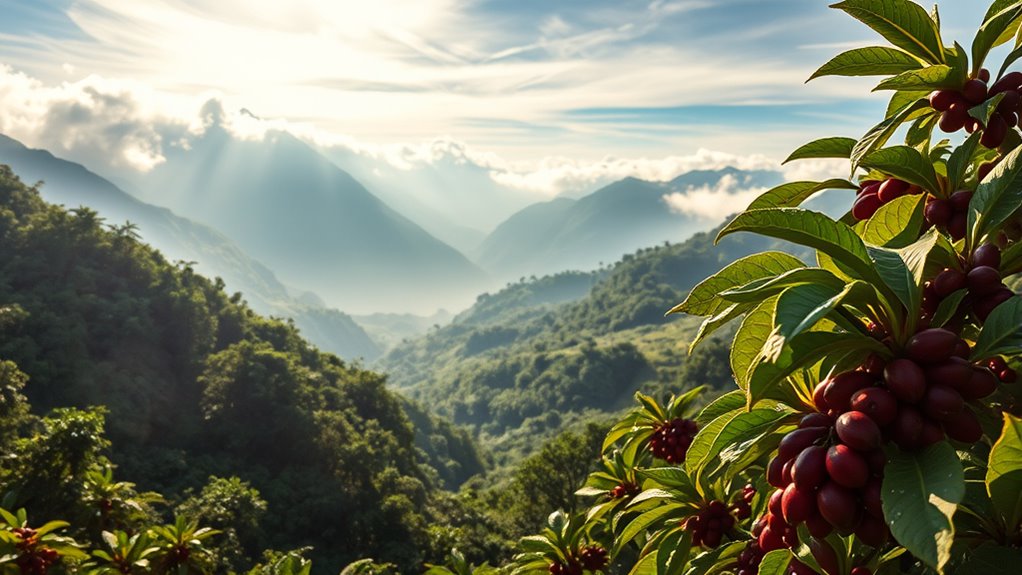Altitude considerably impacts coffee bean quality by enhancing flavor complexity and richness. Coffee grown above 1,300 meters often has a vibrant profile, with fruity and floral notes, thanks to slower maturation and increased sugar concentration. The cooler temperatures at high elevations contribute to brighter acidity and denser beans. Conversely, lower-altitude beans tend to be smoother and less complex. If you’re curious about how these factors affect overall taste and selection, there’s more to discover.
Key Takeaways
- High-altitude coffee beans, grown above 1,300 meters, develop richer flavors and increased acidity due to slower maturation in cooler temperatures.
- Beans from higher elevations exhibit greater density and complexity, showcasing vibrant floral and fruity notes compared to smoother low-altitude varieties.
- Limited water availability at high altitudes enhances flavor concentration, while nutrient-rich volcanic soils contribute crucial nutrients for coffee plants.
- Economic factors include higher production costs due to accessibility challenges in mountainous regions and lower yields per coffee tree.
- Caffeine levels generally decrease with elevation, with high-altitude Arabica beans containing around 1.9% caffeine compared to Robusta at lower elevations.
The Role of Altitude in Coffee Quality

When you consider the impact of altitude on coffee quality, you’ll find that growing conditions play an essential role. Higher altitude coffee beans, typically grown above 1,300 meters, develop unique flavor profiles due to cooler temperatures that slow their growth.
This slower growth allows the beans to concentrate sugars, resulting in richer flavors and increased acidity. You’ll notice that these high-altitude beans often exhibit vibrant floral and fruity notes, setting them apart from their lower-altitude counterparts, which tend to be smoother and less complex.
Additionally, better drainage and reduced water availability at these elevations lead to denser beans, enhancing their overall flavor concentration. This density not only boosts quality but also increases market value, making altitude a vital factor in coffee production.
Characteristics of High-Altitude Coffee Beans
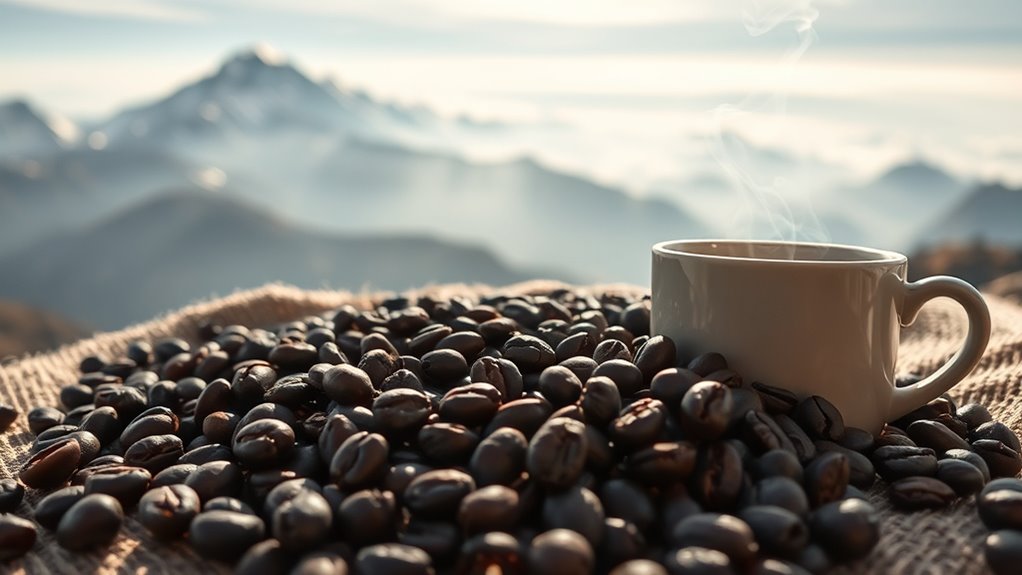
High-altitude coffee beans, cultivated at elevations above 1,300 meters, are renowned for their distinct characteristics that set them apart in the coffee world. These beans, often labeled as SHB (Super Hard Bean) or Altura, demonstrate superior quality and flavor potential. At high elevations, the cooler temperatures slow maturation, leading to denser and smaller beans that concentrate flavor and aroma. Their zig-zagged fissure lines indicate density, while the higher acidity contributes to a brighter cup compared to lower-elevation beans.
| Characteristic | High-Altitude | Low-Elevation |
|---|---|---|
| Bean Density | Denser, compact | Lighter, less dense |
| Flavor Complexity | Fruity, floral | Mellow, smooth |
| Acidity Level | Higher | Lower |
| Maturation Rate | Slower | Faster |
| Fissure Appearance | Zig-zagged | Open |
Flavor Profiles of High Elevation Coffee
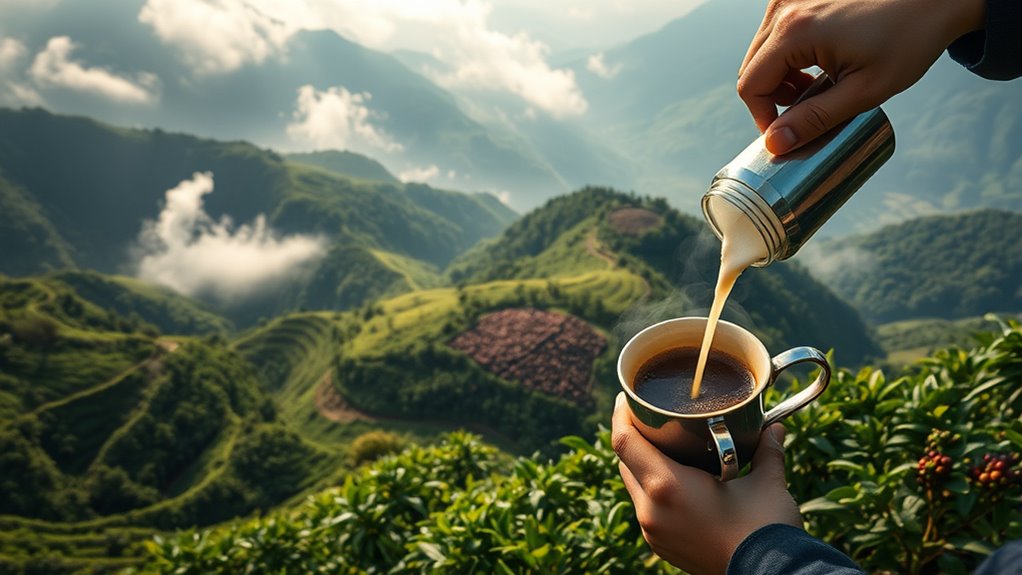
As you explore the flavor profiles of high elevation coffee, you’ll discover a vibrant complexity that sets it apart from its lower elevation counterparts.
Grown at higher elevations, typically above 1,300 meters (4,500 feet), these beans often showcase pronounced floral notes, lively acidity, and a delightful spice.
The slower growth cycles in high-altitude coffee growing regions allow for enhanced sugar development in the cherries, resulting in richer, more concentrated flavors.
You’ll often find fruity and berry notes that are less pronounced in lower elevation varieties.
This brightness and complexity, combined with higher acidity levels, create a fresh and engaging taste experience that distinguishes high elevation coffee from its smoother, mellower counterparts.
Environmental Factors Influencing Coffee Growth

When you’re growing coffee, environmental factors like temperature, water availability, and soil quality play vital roles.
Cooler climates at higher altitudes slow growth but enhance flavor complexity.
Plus, volcanic soils and varying sunlight and rainfall create unique microclimates that shape your coffee’s character.
Temperature and Growth Rate
While many factors contribute to the growth of coffee plants, temperature plays an essential role in shaping their development and, ultimately, the quality of the beans.
At high elevations, cooler temperatures typically range between 16-23°C (60-70°F), which markedly slows the growth rate of coffee plants. This slower growth allows for more complex flavors to develop within the beans, as they mature over a longer period.
The extended maturation time boosts natural sugar production, enhancing the sweetness and acidity that coffee lovers appreciate. Furthermore, high-altitude conditions lead to denser beans, concentrated flavors, and a superior quality profile.
Water Availability Impact
Water availability greatly influences the flavor profile of coffee beans, creating a delicate balance that farmers must manage.
In higher elevations, the cooler climates help slow down the growth of coffee plants, allowing beans to accumulate more sugars. With limited water availability, these beans develop more intense and complex flavors, making them highly sought after in specialty coffee markets.
The better drainage found in mountainous regions reduces excess moisture, further enhancing the concentration of flavors. Managing the right balance of rainfall and water usage is vital during the coffee growth cycle.
When you guarantee ideal water conditions, you’ll produce beans that aren’t only flavorful but also richer and denser, elevating the overall coffee experience.
Soil Quality Variations
Soil quality plays an essential role in determining the health and flavor of coffee beans. In high-altitude regions, you’ll find rich, volcanic soils that provide crucial nutrients for your coffee plants.
These soils also have excellent drainage, preventing waterlogging and supporting healthier root systems. While high-altitude soils often contain lower organic matter, this can lead to more concentrated flavors as the plants efficiently draw nutrients.
The interaction between altitude and soil composition affects mineral availability, enhancing the flavor profile of your coffee beans. Additionally, soil acidity levels can vary with altitude, influencing the overall health of coffee plants and contributing to brighter, more vibrant taste notes in your brew.
Coffee Bean Labels and Grading Systems
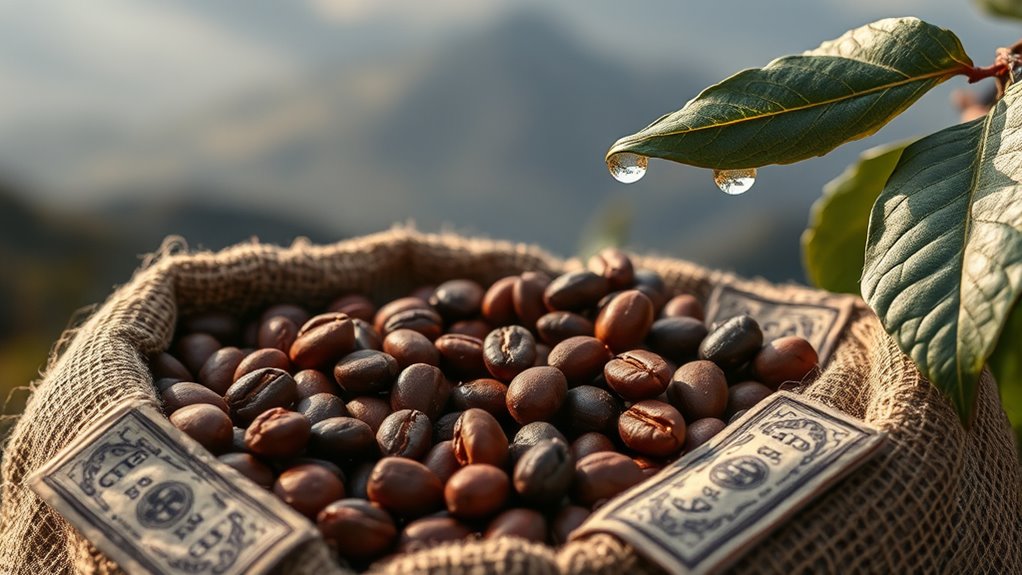
Coffee bean labels and grading systems serve as essential guides for consumers seeking quality and flavor in their brews.
When you see terms like SHB (Strictly Hard Bean) or Altura, you know these beans are grown at high altitudes, typically above 1,300 meters (4,500 feet). For instance, in Guatemala, SHB signifies beans cultivated above 1,370 meters, showcasing their dense structure and rich flavors.
Similarly, Mexico uses Altura to highlight high-altitude coffees known for their complex flavors, while Papua New Guinea’s “Mile High” label emphasizes the quality linked to elevation.
Economic Aspects of High-Grown Coffee
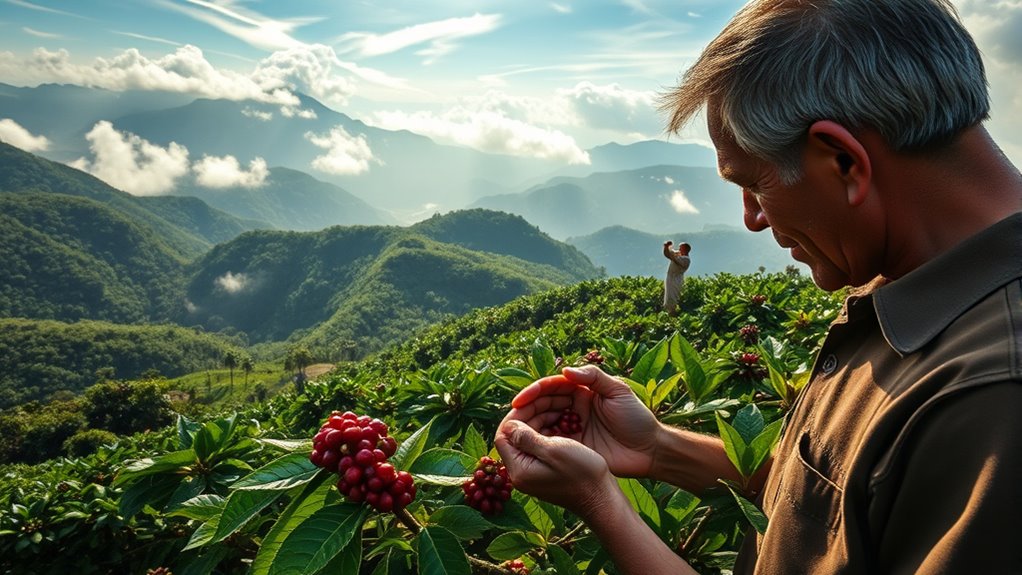
When you’re looking at high-grown coffee, you’ll quickly notice its rarity and premium price tag.
The production costs are higher due to accessibility challenges and the need for specialized techniques in mountainous areas.
This combination of factors not only elevates the coffee’s quality but also its economic value in the market.
Production Costs Overview
While high-grown coffee offers unique flavors and qualities, its production comes with significant economic challenges.
The production costs for high-grown coffee are higher due to the difficulties of accessing remote mountainous regions. You’ll find that the investment in infrastructure and transportation is essential, as these areas often lack proper access.
Additionally, maintaining roads and managing labor costs at high altitudes add to the expenses. With lower yields per coffee tree in these environments, farmers produce fewer beans, which increases the cost per unit.
Ultimately, the complexities involved in cultivating and harvesting high-grown coffee contribute to its premium pricing, reflecting both its rarity and the challenges faced by producers.
Rarity and Pricing
The rarity of high-grown coffee considerably influences its pricing in the market, as limited supply meets high demand.
You’ll find that the unique qualities of high-grown beans reflect their elevated prices due to several factors:
- Limited supply: High-grown coffee is harder to produce, making it scarce.
- Production costs: Higher labor and maintenance expenses arise from challenging terrains.
- Specialized equipment: Farming in remote areas requires unique tools and transport solutions.
- Flavor profiles: The distinct taste of high-grown coffee boosts its desirability.
This combination of rarity and quality creates a premium market environment, driving prices up and making high-grown coffee a sought-after choice for connoisseurs.
Accessibility Challenges Impact
High-grown coffee’s rarity not only drives its pricing but also highlights significant accessibility challenges that impact its economic aspects.
When you consider altitude coffee grown in mountainous regions, you’ll find that high production costs stem from the difficulties in transportation and maintaining roads. These accessibility challenges mean that transporting goods to market isn’t just complicated; it’s costly.
Additionally, labor costs for harvesting high-elevation coffee rise due to the rugged terrain and remote locations. This complexity in cultivation and harvesting contributes to high-grown coffee’s premium pricing, making it even more valuable.
As environmental factors and geographical constraints limit availability, the economic value of high-grown coffee continues to increase, reflecting its unique challenges and exceptional quality.
The Impact of Geography on Coffee Flavor

Geography considerably shapes the flavor of coffee, influencing everything from soil composition to climate conditions.
When you consider how geography affects coffee, keep in mind the following factors:
- Elevation: Higher altitudes above 900 meters create cooler temperatures that enhance flavor complexity.
- Soil Quality: Nutrient-rich soils can lead to more vibrant flavors in your cup.
- Temperatures: Cooler climates slow down maturation, allowing beans to develop richer profiles.
- Rainfall and Sunlight: Variations in these elements affect growth rates and flavor characteristics.
These geographical aspects combine to create the unique taste you savor in each coffee cup, showcasing why location plays such an essential role in determining quality and flavor.
Caffeine Levels in Relation to Altitude
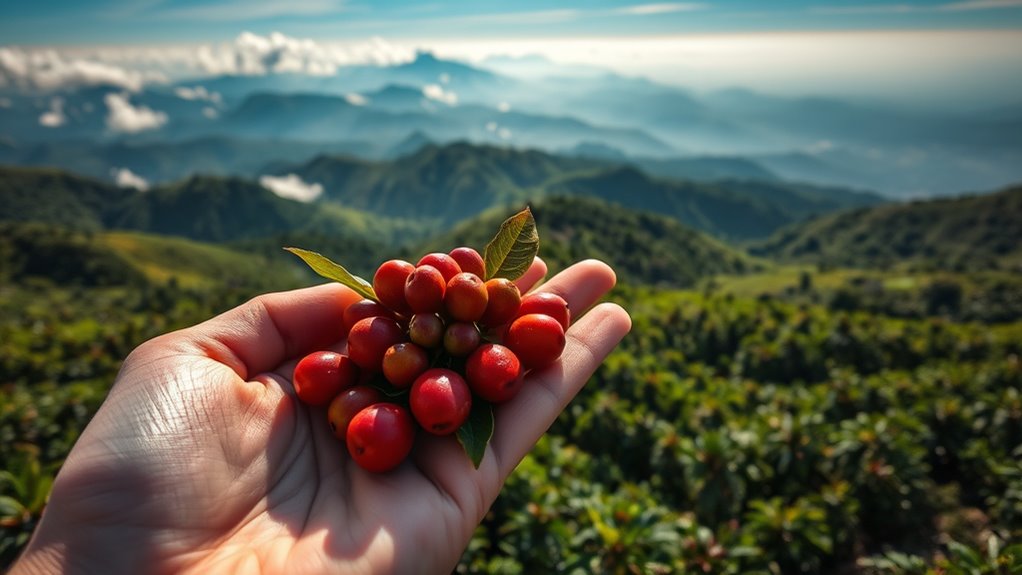
As you explore the relationship between caffeine levels and altitude, you’ll find that elevation plays a significant role in determining the caffeine content of coffee beans. Generally, caffeine levels decrease as you ascend.
For instance, robusta beans, which thrive at lower elevations, contain about 2.9% caffeine, while arabica beans, favored at higher altitudes, have around 1.9%. The cooler temperatures and slower growth cycles at these heights contribute to the development of complex flavors in arabica coffee, compensating for its lower caffeine content.
Furthermore, higher altitudes have fewer pests, allowing for a better flavor balance. While caffeine helps with pest resistance, the trade-off at these elevations is often a more flavorful and aromatic cup of coffee, even with reduced caffeine levels.
Selecting Coffee Based on Elevation Preferences
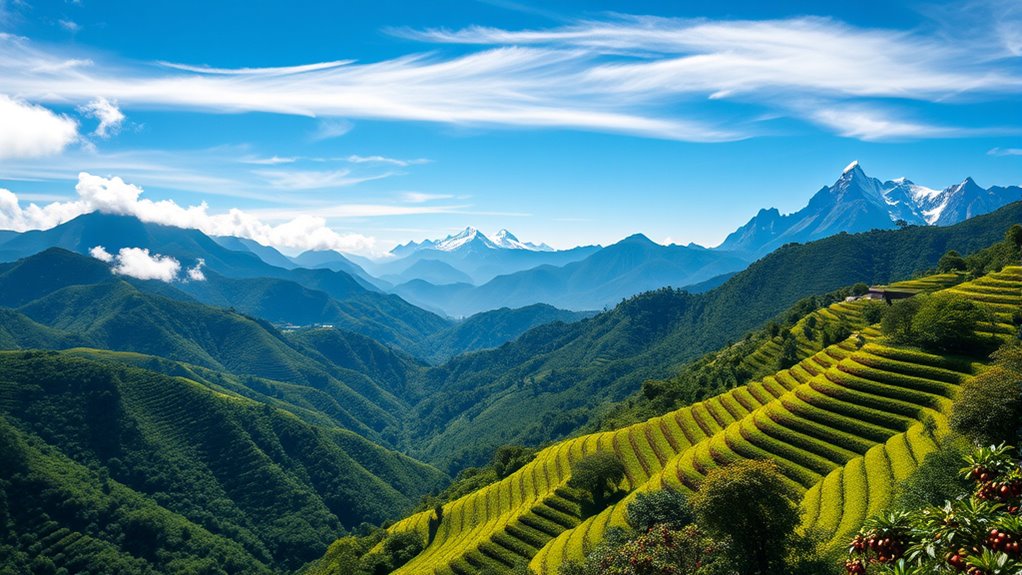
Have you ever wondered how elevation influences your coffee experience? Selecting coffee based on elevation preferences can greatly enhance your enjoyment.
High-altitude beans often stand out due to their unique flavor profiles. Consider these key points when choosing your brew:
- Coffee grown above 1,300 meters typically offers complex flavors and is labeled SHB or Altura.
- High-altitude beans have pronounced acidity and fruity notes, ideal for vibrant flavor preferences.
- Beans from 900 to 1,500 meters benefit from cooler temperatures, enhancing sugar development for richer taste.
- Lower altitude coffees tend to be smoother and mellower, appealing to those who prefer a gentler flavor.
Understanding these differences helps you make informed choices and find the perfect cup for your palate.
Frequently Asked Questions
What Are the Factors Affecting the Quality of Coffee Beans?
When it comes to coffee bean quality, several factors play an essential role.
You’ve got the origin, which influences flavor and aroma. The processing method affects how well the beans retain their characteristics. You can’t forget about the varietal; different species produce distinct flavors.
Additionally, the climate, including temperature and rainfall, impacts growth.
Finally, harvesting techniques are critical to guarantee you pick only the ripest beans, which greatly enhances the final product’s quality.
What Is the Best Altitude to Grow Coffee?
If you’re looking to grow coffee, aim for an altitude between 1,200 and 1,800 meters (4,000 to 6,000 feet).
This range offers cooler temperatures that slow down growth, enhancing the flavor.
You’ll find that coffee grown above 1,300 meters is often labeled as SHB or Altura, indicating superior quality.
These conditions lead to denser beans and complex flavors, making your coffee more desirable in the market.
Does Coffee Brew Different at High Altitude?
You might think brewing coffee at high altitude is just like brewing at sea level, but it isn’t.
The lower atmospheric pressure alters the boiling point of water, affecting how flavors extract. You’ll need to adjust your grind size and brewing time to get the best taste.
Expect a brighter, more pronounced flavor profile, as the higher acidity in the beans can enhance aroma and taste, making your coffee experience even better.
What Makes Coffee Beans High Quality?
High-quality coffee beans stand out due to their flavor complexity, aroma, and overall balance. You’ll notice they often have a rich sweetness and vibrant acidity, which come from their slower growth processes.
Look for beans with closed fissure lines, as these indicate density and maturity. Specialty beans are usually grown under challenging conditions, yielding unique flavor notes like fruity or berry characteristics that elevate your coffee experience to a whole new level.
Conclusion
In the world of coffee, altitude truly makes a difference. When you choose high-altitude beans, you’re not just picking a drink; you’re selecting a unique flavor experience shaped by the environment. Remember, the cream rises to the top, and so do the best qualities in coffee. So, next time you brew a cup, consider the elevation—your taste buds will thank you for it, and you’ll appreciate the rich nuances that come from those lofty heights.
